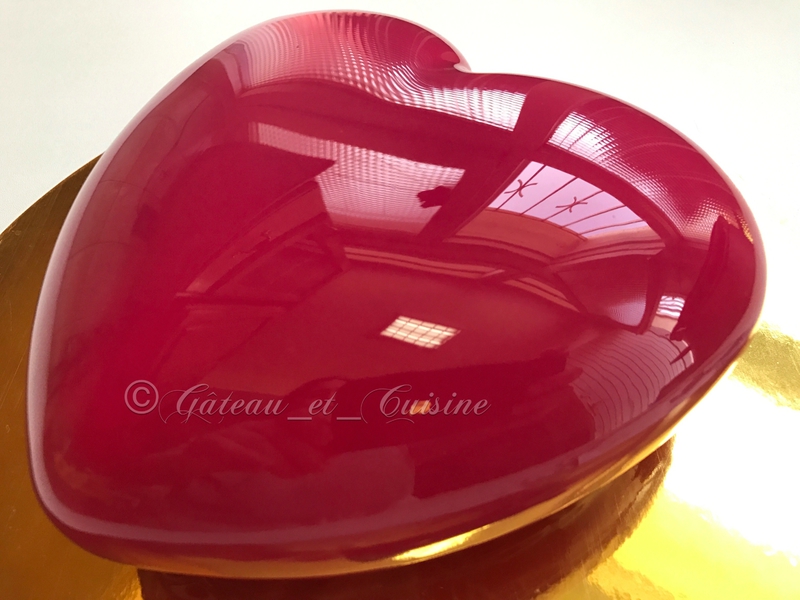
Knowing how to make an ultra glossy chocolate mirror glaze is an essential step for all baking enthusiasts. It enhances mousse cakes and yule logs by giving them a perfect, mirror-like finish.
However, it may seem difficult to achieve for some, but I assure you that it’s not the case. With the right recipe, good tips, and a little practice, you can achieve a perfect mirror glaze with zero bubbles to completely cover your mousse cakes or just the top, as I did for my triple chocolate cake, where a thin layer was enough to enhance it.
I have many glazing recipes on the blog, but the one I’m offering here is the one I use the most and is also highly appreciated by pastry chefs worldwide. It’s the recipe of MOF Jean-Michel Perruchon from the Bellouet Conseil school in Paris. This recipe can be made with dark chocolate, milk chocolate, or white chocolate, which can be colored according to your preferences.
Some fear that this chocolate mirror glaze recipe is too sweet or that it forms a gelatinous layer on the mousse cake. By following the preparation steps and my advice carefully, you’ll obtain a thin layer that blends with the dessert, very pleasant in the mouth.
The recipe can be prepared in less than 15 minutes. Many of you have succeeded on the first try by following my video recipe.
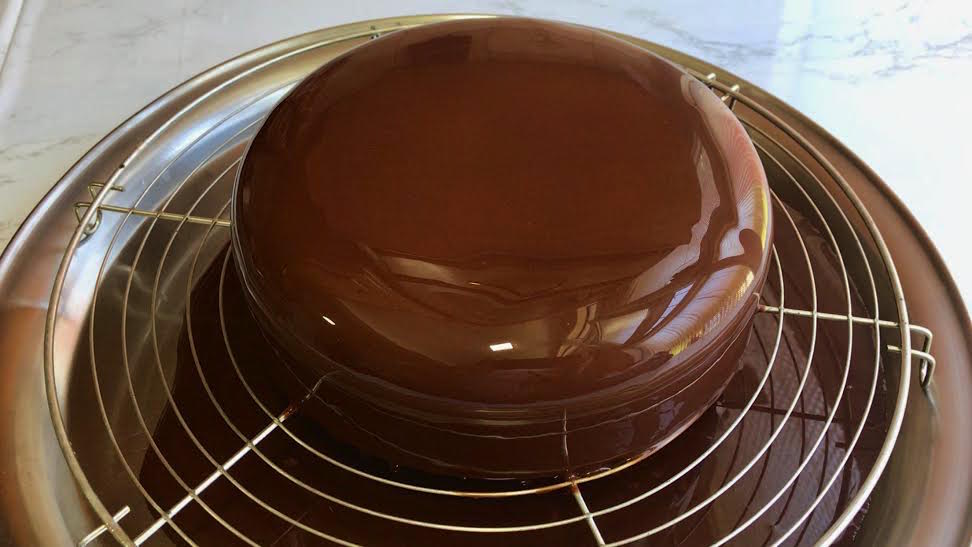
Table of Contents
Details on ingredients and their alternatives:
The main ingredients of this recipe are chocolate, glucose, and condensed milk. Many of you wonder if it’s possible to replace them:
- GlucoseGlucose gives the glaze its characteristic shine. If you don’t have any, you can replace it with honey, choosing a light honey with a neutral taste, such as acacia honey. This will maintain a nice texture and a beautiful shiny finish. For a glaze without glucose, I offer you the recipe below.
- Condensed milkSweetened condensed milk brings smoothness to the taste. After numerous trials, particularly in my glaze without glucose or condensed milk, you can replace it with 30% fat heavy cream. The glaze will then be less sweet while keeping its shine.It’s also possible to use unsweetened condensed milk; however, it gives a more fluid glaze.In this case, you’ll need to pour the glaze at a lower temperature, around 30°C, to ensure good coverage. This also slightly reduces the sugar content.However, after comparison, I recommend keeping the use of sweetened condensed milk or liquid cream while keeping the glucose, to ensure optimal results.
- ChocolateYou can make this recipe with dark chocolate, milk chocolate, white chocolate, or even chocolates like Dulcey or Caramelia. Opt for a couverture chocolate with good fluidity, preferably like Valrhona or Cacao Barry, which also have the advantage of being less sweet.The choice of cocoa content in dark chocolate will influence the texture and color of your glaze: the higher the percentage, the less fluid and darker the glaze will be.I recommend using chocolate with a cocoa content between 55% and 64%. As for white chocolate, it can be colored with either oil-soluble or water-soluble food coloring, as this glaze contains both fat and water.
- GelatinYou can use sheet or powdered gelatin for this recipe. I give you more explanations at the end of the article regarding blooms and gelatin mass.The recommended dosage is 10 g (0.35 oz). However, for dark chocolate, use 9 g (0.32 oz) to obtain a perfect texture.
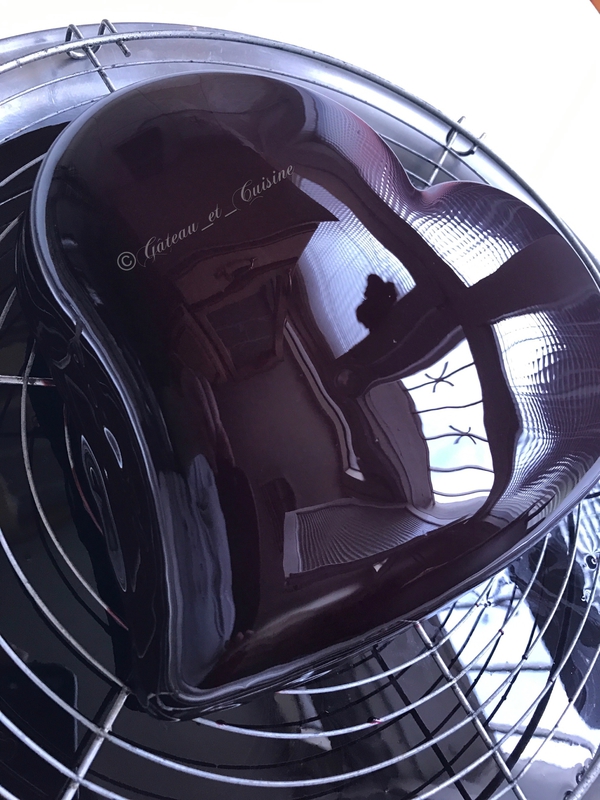
Essential equipment for making an ultra shiny mirror glaze:
- Thermometer:
You’ll need a thermometer, whether it’s a classic one, a probe thermometer, or a laser thermometer. A model under 10 euros will do perfectly. I started with a small thermometer (visible in the video) and it has never let me down. If you want to invest a bit more, the Mastrad probe thermometers or laser thermometers are excellent options, but a bit more expensive.
- Immersion blender:
To get a smooth, fine, and air-bubble-free glaze, this is the essential utensil. Bubbles can ruin the appearance of your entremet. To avoid them, you need to mix the glaze well using an immersion blender. While a simple stick blender can work, the one that gives infallible, bubble-free results is the Bamix immersion blender.
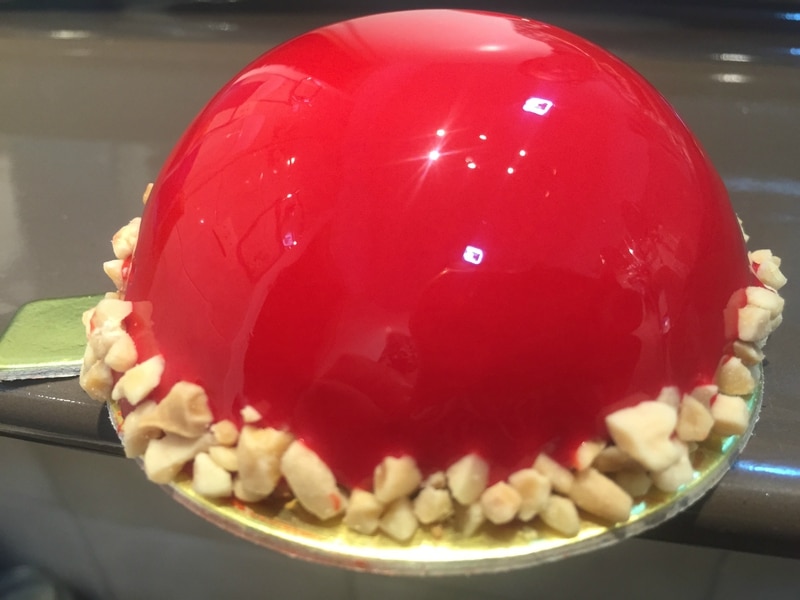
Video recipe:
Ingredients:
Note: Find the printable recipe card and tips to remember at the end of the article.
The recipe can cover an 8/9-inch (20/22 cm) mousse cake or 10 small cakes of 3 inches (7 cm).
- 75 g water (2.6 oz)
- 150 g glucose (5.3 oz)
- 150 g granulated sugar (5.3 oz)
- 100 g sweetened condensed milk or 30% fat heavy cream
- 150 g white chocolate, milk chocolate, or dark chocolate of your choice (5.3 oz). Use a good quality couverture chocolate with 55% to 64% cocoa content (Cacao Barry or Valrhona are the best)
- 10 g of 200 bloom powdered gelatin (0.35 oz) to be rehydrated in 60 g of cold water (2 oz), or 5 sheets of 2 g at 200 bloom (Edit 2024: since then I’ve reduced it to 9 g or 4.5 sheets, and it’s just as good).
- 5 g of fat-soluble or water-soluble food coloring (0.18 oz), powder preferably. Depending on the desired color intensity, 2 to 3 g (0.07 to 0.11 oz) may be sufficient. To be used with white chocolate for a colored glaze.
Preparation steps :
Use on a frozen mousse cake
If using sheet gelatin: soak it in very cold water to rehydrate, about 10 minutes before starting the glaze preparation. Squeeze it well before adding it to the hot mixture.
If using powdered gelatin: bloom it in the indicated amount of cold water, at least 15 to 20 minutes before starting (keep it in the refrigerator). You will obtain what is called the gelatin mass.
Prepare the syrup: put the water, glucose, and sugar in a saucepan. Heat until it reaches 103°C (217°F), stirring occasionally without splashing the sides. If this happens, clean the sides of the pan with a damp brush.
Pour the hot syrup through a strainer over the condensed milk and coloring, then add the squeezed gelatin (if using sheets) or the gelatin mass (if using powder). You can also add the coloring after blending, which allows you to divide the glaze into several parts and color them differently.
Mix gently with a spatula, then pour over the chocolate placed in a tall, narrow container (like a measuring jug or the container provided with your immersion blender). Wait a minute before stirring gently with the spatula.
Blend for 3 to 4 minutes with an immersion blender. This step is crucial: to avoid creating bubbles, slightly tilt the container and always keep the blender immersed without removing it, except at the end.
You’ll notice that the more correctly you blend, the more shiny and fluid the glaze becomes.
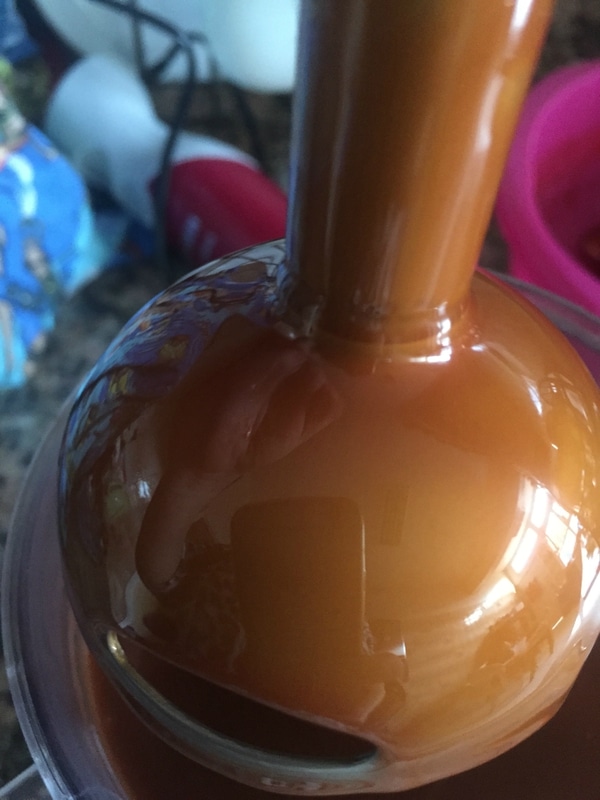
Pour the glaze through a fine sieve into an airtight container, then cover it with plastic wrap touching the surface. Place in the refrigerator until the next day.
The next day, pour the glaze into a saucepan and gently heat it to a maximum of 38-40°C (100-104°F), using a double boiler or in the microwave.
Remove regularly from the double boiler (or microwave), stir, then put back to heat. This allows you to control the temperature and melt the mixture well without overheating it.
Note: If at 35-36°C (95-97°F) the glaze is almost entirely melted, it’s perfect. The blending will finish melting the last pieces, allowing you to reach the ideal usage temperature more quickly.
Then pour into a tall, narrow pouring jug, and blend with an immersion blender to eliminate all bubbles. The glaze then becomes smooth and ultra-shiny: you can almost see yourself as in a mirror.
What’s the ideal temperature for using chocolate glaze?
When the glaze reaches 33-34°C (91.4-93.2°F), take the entremets out of the freezer (freezing is essential to ensure the glaze holds perfectly).
Note: You can also glaze at a slightly lower or higher temperature depending on the desired texture. At 33-34°C, the texture is optimal: fluid yet covering.
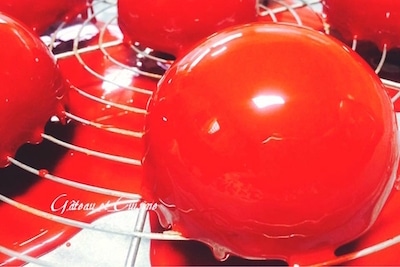
Using the chocolate glaze on a mousse Cake:
Place the mousse cake on a wire rack or a smaller stand to elevate it. Set everything on a tray lined with plastic wrap to easily catch any excess glaze. Gently run your hand over the surface or use a paper towel to remove any traces of frost before glazing.
Pour the glaze evenly, making sure to fully cover the cake. You can lightly run a spatula over the top in one smooth, quick motion to even it out.
Let the glaze drip naturally. Once it stops dripping, slide two long spatulas under the mousse cake and gently rub them against the rack with a back-and-forth motion to cleanly cut off the excess glaze.
If the cake is elevated, trim any remaining drips using clean scissors or a sharp knife.
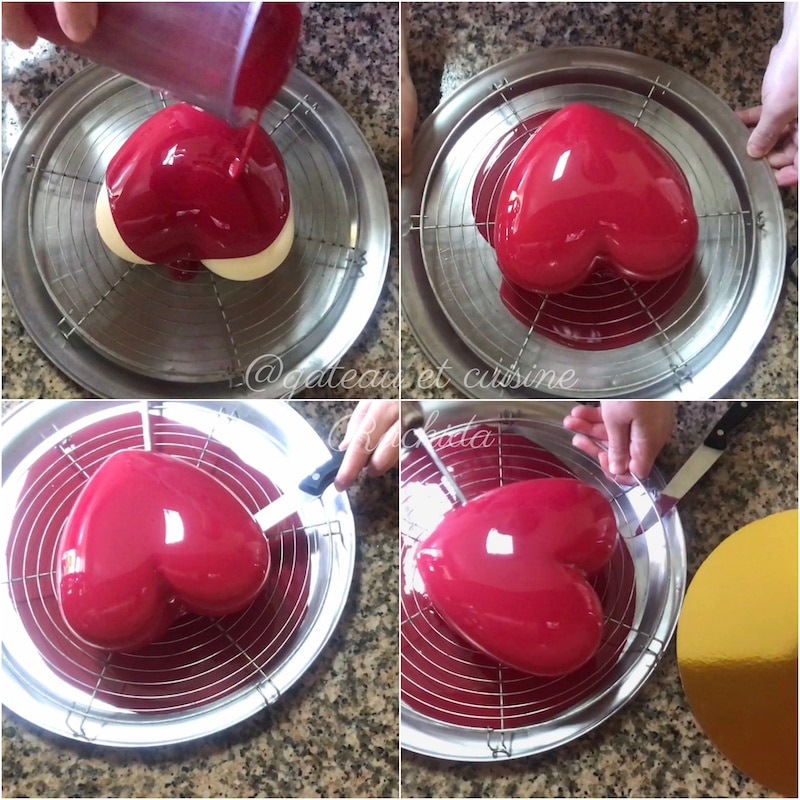
Gently transfer the mousse cake onto a serving platter or a gold cake board. Let it thaw in the refrigerator for at least 6 hours.
If you’re short on time, you can also let it thaw at room temperature, but the texture will be more stable with a slow defrost in the fridge.
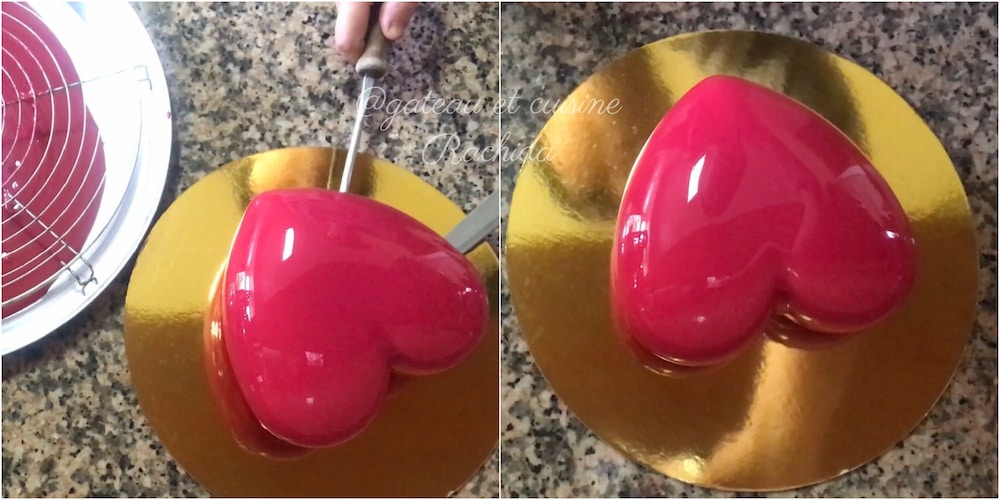
Tips and tricks for a successful mirror glaze:
How to store leftover chocolate mirror glaze?
Chocolate mirror glaze keeps very well. You can store leftovers in an airtight container in the refrigerator for 3 to 4 days. To reuse, gently reheat it in a double boiler or microwave without exceeding 38°C (100°F). Strain it through a fine sieve to remove any particles, then blend again to restore a smooth and shiny texture.
It can also be frozen for up to 3 months. Let it thaw overnight in the refrigerator, then reheat, strain, and blend before use.
What to do if your chocolate glaze is too thick?
This can be caused by overcooking the syrup above 103°C ( 217°F), using chocolate that is too high in cocoa and not fluid enough, or adding too much gelatin. A glaze that is too cold can also be less fluid.
Try pouring it at a slightly higher temperature. If that’s not enough, you can try to fix it by adding a little hot water and blending carefully.
For your next preparation, be sure to check your thermometer’s accuracy and adjust the type of chocolate or the amount of gelatin if needed.
What to do if your mirror glaze is too runny?
A glaze that is too runny can be caused by a temperature that is too high, an undercooked syrup, or a lack of gelatin.
Let it cool for a few minutes and test again. If the problem persists, add a few melted chocolate callets, then blend to regain the right consistency.
In the future, make sure to cook the syrup to 103°C ( 217°F ) and respect the gelatin proportions.
Which gelatin to use in a mirror glaze recipe?
You can use either gelatin sheets or powdered gelatin. The bloom number indicates the gelling strength: the higher the number, the stronger the gelatin. The most commonly used are bronze gelatin (150 blooms), silver (180 blooms), and gold (200 blooms), with the latter being the most popular in pastry making.
For powdered gelatin, rehydrate it in 6 times its weight in cold water. For example, for 10 g (0.35 oz) of gelatin, add 60 g (2 oz) of water: this will give you 70 g (2.47 oz) of gelatin mass ready to be incorporated into a hot preparation.
How to avoid air bubbles in the mirror glaze cake?
Use an immersion blender without a bell (like the Bamix) in a tall, narrow container. Blend slowly, keeping the blender upright and fully submerged to avoid incorporating air.
Once the glaze is ready, if there are still a few bubbles, strain it through a fine mesh sieve to remove them. Finally, if you have time, let the glaze rest overnight in the refrigerator to get rid of any stubborn bubbles.
You can now enhance all your entremets with this ultra-shiny chocolate mirror glaze!

Other Glaze Recipe
Chocolate and cocoa mirror glaze

Chocolate Mirror Glaze Recipe
INGREDIENTS
- 75 g water
- 150 g glucose
- 150 g granulated sugar
- 100 g sweetened condensed milk or 30% fat heavy cream
- 150 g white chocolate milk chocolate, or dark chocolate of your choice . Use a good quality couverture chocolate with 55% to 64% cocoa content (Cacao Barry or Valrhona are the best)
- 10 g of 200 bloom powdered gelatin to be rehydrated in 60 g of cold water (2 oz), or 5 sheets of 2 g at 200 bloom (Edit 2024: since then I’ve reduced it to 9 g or 4.5 sheets, and it’s just as good).
- 5 g of fat-soluble or water-soluble food coloring preferably powder. Depending on the desired color intensity, 2 to 3 g (0.07 to 0.11 oz) may be sufficient. To be used with white chocolate for a colored glaze.
PREPARATION
- Use on a frozen mousse cake
- If using sheet gelatin: soak it in very cold water to rehydrate, about 10 minutes before starting the glaze preparation. Squeeze it well before adding it to the hot mixture.
- If using powdered gelatin: bloom it in the indicated amount of cold water, at least 15 to 20 minutes before starting (keep it in the refrigerator). You will obtain what is called the gelatin mass.
- Prepare the syrup: put the water, glucose, and sugar in a saucepan. Heat until it reaches 103°C (217°F), stirring occasionally without splashing the sides. If this happens, clean the sides of the pan with a damp brush.
- Pour the hot syrup through a strainer over the condensed milk and coloring, then add the squeezed gelatin (if using sheets) or the gelatin mass (if using powder). You can also add the coloring after blending, which allows you to divide the glaze into several parts and color them differently.
- Mix gently with a spatula, then pour over the chocolate placed in a tall, narrow container (like a measuring jug or the container provided with your immersion blender). Wait a minute before stirring gently with the spatula.
- Blend for 3 to 4 minutes with an immersion blender. This step is crucial: to avoid creating bubbles, slightly tilt the container and always keep the blender immersed without removing it, except at the end.
- You’ll notice that the more correctly you blend, the more shiny and fluid the glaze becomes.
- Pour the glaze through a fine sieve into an airtight container, then cover it with plastic wrap touching the surface. Place in the refrigerator until the next day.
- The next day, pour the glaze into a saucepan and gently heat it to a maximum of 38-40°C (100-104°F), using a double boiler or in the microwave.
- Remove regularly from the double boiler (or microwave), stir, then put back to heat. This allows you to control the temperature and melt the mixture well without overheating it.
- Note: If at 35-36°C (95-97°F) the glaze is almost entirely melted, it’s perfect. The blending will finish melting the last pieces, allowing you to reach the ideal usage temperature more quickly.
- Then pour into a tall, narrow pouring jug, and blend with an immersion blender to eliminate all bubbles. The glaze then becomes smooth and ultra-shiny: you can almost see yourself as in a mirror.
What’s the ideal temperature for using chocolate glaze?
- When the glaze reaches 33-34°C (91.4-93.2°F), take the entremets out of the freezer (freezing is essential to ensure the glaze holds perfectly).
- Note: You can also glaze at a slightly lower or higher temperature depending on the desired texture. At 33-34°C, the texture is optimal: fluid yet covering.
Using the chocolate glaze on a mousse Cake:
- Place the mousse cake on a wire rack or a smaller stand to elevate it. Set everything on a tray lined with plastic wrap to easily catch any excess glaze. Gently run your hand over the surface or use a paper towel to remove any traces of frost before glazing.
- Pour the glaze evenly, making sure to fully cover the cake. You can lightly run a spatula over the top in one smooth, quick motion to even it out.
- Let the glaze drip naturally. Once it stops dripping, slide two long spatulas under the mousse cake and gently rub them against the rack with a back-and-forth motion to cleanly cut off the excess glaze.
- If the cake is elevated, trim any remaining drips using clean scissors or a sharp knife.
- Gently transfer the mousse cake onto a serving platter or a gold cake board. Let it thaw in the refrigerator for at least 6 hours.
- If you're short on time, you can also let it thaw at room temperature, but the texture will be more stable with a slow defrost in the fridge.
Thank you for your visit and your comments!

